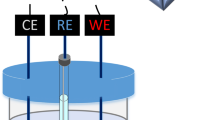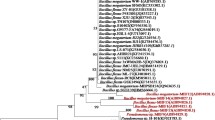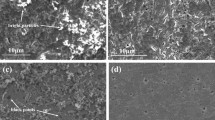Abstract
Most microbiologically influenced corrosion (MIC) studies focus on the threat of pinhole leaks caused by MIC pitting. However, microbes can also lead to structural failures. Tetrakis hydroxymethyl phosphonium sulfate (THPS) biocide mitigated the microbial degradation of mechanical properties of X80 steel pipeline by Desulfovibrio ferrophilus (IS5 strain), a very corrosive sulfate reducing bacterium. It was found that 100 ppm (w/w) THPS added to the enriched artificial seawater (EASW) culture medium before incubation resulted in 2.8-log reduction in sessile cell count after a 7-d incubation at 28 °C under anaerobic conditions, leading to 94% uniform corrosion rate reduction (from 1.3 to 0.07 mm/a), and 84% pitting corrosion rate reduction (from 0.70 to 0.11 mm/a). The X80 dogbone coupon incubated with 100 ppm THPS for 7 d suffered 3% loss in ultimate tensile strain and 0% loss in ultimate tensile strength compared with the abiotic control in EASW. In comparison, the no-treatment X80 dogbone coupon suffered losses of 13% in ultimate tensile strain and 6% in ultimate tensile stress, demonstrating very good THPS efficacy.










Similar content being viewed by others
References
ASTM-E8/E8M-13a (2013) Standard test methods for tension testing of metallic materials. ASTM International, West Conshohocken, PA
ASTM G1-03 (2017) Standard practice for preparing, cleaning, and evaluating corrosion test specimens. ASTM International, West Conshohocken, PA
Anandkumar B, George RP, Maruthamuthu S, Parvathavarthini N, Mudali UK (2016) Corrosion characteristics of sulfate-reducing bacteria (SRB) and the role of molecular biology in SRB studies: an overview. Corros Rev 34:41–63
Ashassi-Sorkhabi H, Moradi-Haghighi M, Zarrini G, Javaherdashti R (2012) Corrosion behavior of carbon steel in the presence of two novel iron-oxidizing bacteria isolated from sewage treatment plants. Biodegradation 23:69–79
Batmanghelich F, Li L, Seo Y (2017) Influence of multispecies biofilms of Pseudomonas aeruginosa and Desulfovibrio vulgaris on the corrosion of cast iron. Corros Sci 121:94–104
Belén GF, Fernando MA, Diego CL, Sindy SP (2011) Stress–strain relationship in axial compression for concrete using recycled saturated coarse aggregate. Constr Build Mater 25:2335–2342
Burns AS, Pugh CW, Segid YT, Behum PT, Lefticariu L, Bender KS (2012) Performance and microbial community dynamics of a sulfate-reducing bioreactor treating coal generated acid mine drainage. Biodegradation 23:415–429
Chandra K, Mahanti A, Singh AP, Kain V, Gujar HG (2019) Microbiologically influenced corrosion of 70/30 cupronickel tubes of a heat-exchanger. Eng Fail Anal 105:1328–1339
Chen S, Deng H, Zhao Y, Lu S, Zhao Y, Cheng X, Liu G, Dou W, Chen J (2021) The effects of Methanococcus maripaludis on the corrosion behavior of EH40 steel in seawater. Bioelectrochemistry 140:107824
Chen Z, Dou W, Chen S, Pu Y, Xu Z (2022) Influence of nutrition on Cu corrosion by Desulfovibrio vulgaris in anaerobic environment. Bioelectrochemistry 144:108040
Cheng X, Shi J, Wang W, Liao H, Chen S, Liu G, Chen J (2021) Constructing nanostructured functional film on EH40 steel surface for anti-adhesion of Pseudomonas aeruginosa. Surf Coat Technol 405:126683
Cui L, Liu Z, Xu D, Hu P, Shao J, Du C, Li X (2020) The study of microbiologically influenced corrosion of 2205 duplex stainless steel based on high-resolution characterization. Corros Sci 174:108842
Dao VH, Ryu HK, Yoon KB (2021) Leak failure at the TP316L welds of a water pipe caused by microbiologically influenced corrosion. Eng Fail Anal 122:105244
Dinh HT, Kuever J, Mußmann M, Hassel AW, Stratmann M, Widdel F (2004) Iron corrosion by novel anaerobic microorganisms. Nature 427:829–832
Farooq A, Zubair M, Wadood HZ, Deen KM (2021) Effect of Pseudomonas aeruginosa strain ZK biofilm on the mechanical and corrosion behavior of 316L stainless steel and α-brass. J Electrochem Sci Technol 12:431–439
Hamilton WA (1998) Bioenergetics of sulphate-reducing bacteria in relation to their environmental impact. Biodegradation 9:201–212
Jacobson G (2007) Corrosion at prudhoe bay—a lesson on the line. Mater Perform 46:26–34
Jia R, Tan J, Jin P, Blackwood DJ, Xu D, Gu T (2018) Effects of biogenic H2S on the microbiologically influenced corrosion of C1018 carbon steel by sulfate reducing Desulfovibrio vulgaris biofilm. Corros Sci 130:1–11
Jia R, Unsal T, Xu D, Lekbach Y, Gu T (2019) Microbiologically influenced corrosion and current mitigation strategies: a state of the art review. Int Biodeter Biodegr 137:42–58
Jia R, Yang D, Dou W, Liu J, Zlotkin A, Kumseranee S, Punpruk S, Li X, Gu T (2019) A sea anemone-inspired small synthetic peptide at sub-ppm concentrations enhanced biofilm mitigation. Int Biodeter Biodegr 139:78–85
Jin Z, Liu H, Wang Z, Zhang W, Chen Y, Zhao T, Meng G, Liu H, Liu H (2022) Enhancement of anticorrosion and antibiofouling performance of self-healing epoxy coating using nano-hydrotalcite materials and bifunctional biocide sodium pyrithione. Progress Organ Coat 172:107121
Kahrilas GA, Blotevogel J, Stewart PS, Borch T (2015) Biocides in hydraulic fracturing fluids: a critical review of their usage, mobility, degradation, and toxicity. Environ Sci Technol 49:16–32
Li Z, Yang J, Guo H, Kumseranee S, Punpruk S, Mohamed ME, Saleh MA, Gu T (2021) Carbon source starvation of a sulfate-reducing bacterium-elevated MIC deterioration of tensile strength and strain of X80 pipeline steel. Front Mater 8:536
Li Z, Yang J, Guo H, Kumseranee S, Punpruk S, Mohamed ME, Saleh MA, Gu T (2022) Mechanical property degradation of X80 pipeline steel due to microbiologically influenced corrosion caused by Desulfovibrio vulgaris. Front Bioeng Biotechnol 10:1028462
Li Y, Yang L, Liao Y, Zhao R, Ji L, Su R, Xu D, Wang F (2023) Photothermal heating-assisted superior antibacterial and antibiofilm activity of high-entropy-alloy nanoparticles. Adv Funct Mater. https://doi.org/10.1002/adfm.202302712
Liang C, Wang H, Huang N (2014) Effects of sulphate-reducing bacteria on corrosion behaviour of 2205 duplex stainless steel. J Iron Steel Res Int 21:444–450
Lindsell K, Wang S, Clarke J, Jambayev A, Ricquebourg J, Kaipov Y, Zakharov L, Hollaender F (2015) In-line measurement of H2S content in flow with a multiphase flow meter-case study in a giant field under sour gas re-injection. In: Abu Dhabi international petroleum exhibition and conference. Curran Associates, Red Hook
Liu H, Jin Z, Liu H, Meng G, Liu H (2022) Microbiological corrosion acceleration of N80 steel in shale gas field produced water containing Citrobacter amalonaticus at 60 ℃. Bioelectrochemistry 148:108253
Lu S, Dou W, Gu T, Chen S, Cheng X, Hou R, Wang Y, Zhang Y, Liu G (2023) Extracellular electron transfer corrosion mechanism of two marine structural steels caused by nitrate reducing Halomonas titanicae. Corros Sci 217:111125
Lu S, He Y, Xu R, Wang N, Chen S, Dou W, Cheng X, Liu G (2023) Inhibition of microbial extracellular electron transfer corrosion of marine structural steel with multiple alloy elements. Bioelectrochemistry 151:108377
Melchers RE (2005) The effect of corrosion on the structural reliability of steel offshore structures. Corros Sci 47:2391–2410
Ning J, Zheng Y, Brown B, Young D, Nesic S (2015) Construction and verification of pourbaix diagrams for hydrogen sulfide corrosion of mild steel. NACE CORROSION. NACE, Houston
Okoro CC, Samuel O, Lin J (2016) The effects of tetrakis-hydroxymethyl phosphonium sulfate (THPS), nitrite and sodium chloride on methanogenesis and corrosion rates by methanogen populations of corroded pipelines. Corros Sci 112:507–516
Peck HD (1993) Bioenergetic strategies of the sulfate-reducing bacteria. In: Odom JM, Singleton R (eds) Sulfate-reducing bacteria: contemporary perspectives. Springer, New York, pp 41–76
Rahmani K, Jadidian R, Haghtalab S (2016) Evaluation of inhibitors and biocides on the corrosion, scaling and biofouling control of carbon steel and copper–nickel alloys in a power plant cooling water system. Desalination 393:174–185
Sanchez CJ, Akers KS, Romano DR, Woodbury RL, Hardy SK, Murray CK, Wenke JC (2014) D-amino acids enhance the activity of antimicrobials against biofilms of clinical wound isolates of Staphylococcus aureus and Pseudomonas aeruginosa. Antimicrob Agents Chemother 58:4353–4361
Shiibashi M, Deng X, Miran W, Okamoto A (2020) Mechanism of anaerobic microbial corrosion suppression by mild negative cathodic polarization on carbon steel. Environ Sci Technol Let 7:690–694
Silva P, Oliveira SH, Vinhas GM, Carvalho LJ, Barauna OS, Urtiga SL, Lima MAGA (2021) Tetrakis hydroxymethyl phosphonium sulfate (THPS) with biopolymer as strategy for the control of microbiologically influenced corrosion in a dynamic system. Chem Eng Process 160:108272
Smith NW, Shorten PR, Altermann E, Roy NC, McNabb WC (2019) A mathematical model for the hydrogenotrophic metabolism of sulphate-reducing bacteria. Front Microbiol 10:1652
Su Z, Li X, Xi Y, Xie T, Liu Y, Liu B, Liu H, Xu W, Zhang C (2022) Microbe-mediated transformation of metal sulfides: mechanisms and environmental significance. Sci Total Environ 825:153767
Tan J, Wu X, Han E, Ke W, Wang X, Sun H (2017) Strain-rate dependent fatigue behavior of 316LN stainless steel in high-temperature water. J Nucl Mater 489:33–41
Videla HA (2002) Prevention and control of biocorrosion. Int Biodeter Biodegr 49:259–270
Wadood HZ, Rajasekar A, Farooq A, Deen KM (2023) Effect of Bacillus and Pseudomonas biofilms on the corrosion behavior of AISI 304 stainless steel. Int J Mater Res 114:118–126
Wadood HZ, Rajasekar A, Farooq A, Ting Y-P, Sabri AN (2020) Biocorrosion inhibition of Cu70:Ni30 by Bacillus subtilis strain S1X and Pseudomonas aeruginosa strain ZK biofilms. J Basic Microb 60:243–252
Wadood HZ, Rajasekar A, Ting YP, Sabari AN (2015) Role of Bacillus subtilis and Pseudomonas aeruginosa on corrosion behaviour of stainless steel. Arab J Sci Eng 40:1825–1836
Wang D, Ivanova SA, Hahn R, Gu T (2022) Evaluation of trehalase as an enhancer for a green biocide in the mitigation of Desulfovibrio vulgaris biocorrosion of carbon steel. Bioproc Biosyst Eng 45:659–667
Wang D, Kijkla P, Mohamed ME, Saleh MA, Kumseranee S, Punpruk S, Gu T (2021) Aggressive corrosion of carbon steel by Desulfovibrio Ferrophilus IS5 biofilm was further accelerated by riboflavin. Bioelectrochemistry 142:107920
Wang J, Li C, Zhang X, Asif M, Zhang T, Hou B, Li Y, Xia W, Wang H, Liu H (2019) Corrosion behavior of Aspergillus Niger on 7075 aluminum alloy and the inhibition effect of zinc pyrithione biocide. J Electrochem Soc 166:G39–G46
Wang D, Liu J, Jia R, Dou W, Kumseranee S, Punpruk S, Li X, Gu T (2020) Distinguishing two different microbiologically influenced corrosion (MIC) mechanisms using an electron mediator and hydrogen evolution detection. Corros Sci 177:108993
Wang L, Wang H, Seyeux A, Zanna S, Pailleret A, Nesic S, Marcus P (2023) Adsorption mechanism of quaternary ammonium corrosion inhibitor on carbon steel surface using ToF-SIMS and XPS. Corros Sci 213:110952
Wang Y, Wu J, Zhang D, Li E, Zhu L (2021) The inhibition effects of Cu and Ni alloying elements on corrosion of HSLA steel influenced by Halomonas titanicae. Bioelectrochemistry 141:107884
Wei B, Qin Q, Bai Y, Yu C, Xu J, Sun C, Ke W (2019) Short-period corrosion of X80 pipeline steel induced by AC current in acidic red soil. Eng Fail Anal 105:156–175
Witek M (2015) Possibilities of using X80, X100, X120 high-strength steels for onshore gas transmission pipelines. J Nat Gas Sci Eng 27:374–384
Wu C, Wang Z, Zhang Z, Zhang B, Ma G, Yao Q, Gan Z, Wu J, Li X (2021) Influence of crevice width on sulfate-reducing bacteria (SRB)-induced corrosion of stainless steel 316 L. Corros Commun 4:33–44
Xu L, Guan F, Ma Y, Zhang R, Zhang Y, Zhai X, Dong X, Wang Y, Duan J, Hou B (2022) Inadequate dosing of THPS treatment increases microbially influenced corrosion of pipeline steel by inducing biofilm growth of Desulfovibrio hontreensis SY-21. Bioelectrochemistry 145:108048
Xu L, Kijkla P, Kumseranee S, Punpruk S, Gu T (2023) Corrosion-resistant chromium steels for oil and gas pipelines can suffer from very severe pitting corrosion by a sulfate-reducing bacterium. J Mater Sci Technol 174:23–29
Xu D, Lovley DR, Gu T (2023) Microbially mediated metal corrosion. Nat Rev Microbiol 21:705–718
Yang X, Shao J, Liu Z, Zhang D, Cui L, Du C, Li X (2020) Stress-assisted microbiologically influenced corrosion mechanism of 2205 duplex stainless steel caused by sulfate-reducing bacteria. Corros Sci 173:108746
Yin K, Liu H, Cheng Y (2018) Microbiologically influenced corrosion of X52 pipeline steel in thin layers of solution containing sulfate-reducing bacteria trapped under disbonded coating. Corros Sci 145:271–282
Zen K (2005) Corrosion and life cycle management of port structures. Corros Sci 47:2353–2360
Zhao X, Duan J, Hou B, Wu S (2007) Effect of sulfate-reducing bacteria on corrosion behavior of mild steel in sea mud. J Mater Sci Technol 23:323–328
Acknowledgements
Chinese Society for Corrosion and Protection (CSCP) and Corrosion & Protection Center, University of Science & Technology Beijing financially supported this project. W. Dou received financial support from Institute of Marine Science and Technology, Shandong University, China.
Author information
Authors and Affiliations
Contributions
ZL, JY, and SL did the experiments. ZL, WD and TG wrote the manuscript.
Corresponding authors
Ethics declarations
Competing interests
The authors declare no competing interests.
Additional information
Publisher’s Note
Springer Nature remains neutral with regard to jurisdictional claims in published maps and institutional affiliations.
Rights and permissions
Springer Nature or its licensor (e.g. a society or other partner) holds exclusive rights to this article under a publishing agreement with the author(s) or other rightsholder(s); author self-archiving of the accepted manuscript version of this article is solely governed by the terms of such publishing agreement and applicable law.
About this article
Cite this article
Li, Z., Yang, J., Lu, S. et al. Mitigation of Desulfovibrio ferrophilus IS5 degradation of X80 carbon steel mechanical properties using a green biocide. Biodegradation (2024). https://doi.org/10.1007/s10532-023-10063-0
Received:
Accepted:
Published:
DOI: https://doi.org/10.1007/s10532-023-10063-0




